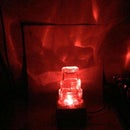Introduction: Minion Cubecraft Toy (A Flashlight Toy)
Since a long time I wanted to make a torch to use it in the dark, but the idea of having just a cylindrical shaped object with just on-off switch made resisted me not to make it. It was too mainstream. Then one day my brother brought a small PCB with two white 10mm LED attached to it. It looked like someone's eye. It struck to me that it would be so great if I make a flashlight but also give it a shape of a toy. This thought made me to build this project.
I've clicked pictures of all the steps involved in making this project and I'll try to explain the steps as simple as possible. Further doubts would be cleared in the comments section.
The materials used in this project are:-
- White LED 10mm (2pcs.),
- Small piece of perfboard (small enough to fix the LED)
- Single Strand Wires and Jumpers (preferably of 2 different colours)
- Switch
- 3V Battery Holder
- Two 1.5V AA cells (can even use AAA cells)
- Coloured A4 size sheet (body)
- Cardboard (for the base)
Step 1: The Main Element
Solder the white LED's on the perfboard. The size of the perfboard depend on the size of the project one wants to make.
Bend the longer leg of the two LEDs towards each other (which is the anode terminal) and short them by joining the two with solder or with the help of jumpers. Now at the shorter leg of the LED (cathode) attach any resistance values from 100 ohms to 1000 ohms on each led. Less the resistance, more bright the LED will glow. (Resistor values is identified from its colour code, for more details, refer here: https://www.electronics-tutorials.ws/resistor/res_... ). Here I've used 680-ohm resistor (colour code: blue->grey->brown->gold) after much experimentation as with 3V supply the LED's give sufficient brightness in the dark and also doesn't cause much glare in the eyes.
Now short the other end of the resistors with a wire and solder it.
Take out long wires from the anode and the other end of the resistor which is just soldered so that the setup can be attached later on.
Step 2: The Skeleton
I've found this net of Minion by searching 'Cubecraft' on Google Images. There are many more characters present there. I thought of putting the LEDs as the eyes and a system of pressing the switch in minion's stomach which will turn on-off the light.
Draw the layout on a coloured sheet and cut it with a paper cutter. One can also stick the layout on the paper and then cut. A separate cover should be made for LED so that it could be fixed inside the body firmly.
Step 3: Wiring
(See the images attached side by side for more clarity on points below)
Now the wiring has to be done according to the circuit diagram given in the first image.
LED: (2nd & 3rd image)
Make a small slot in the neck region. Fix the LED as per your choice and take out the Anode and Cathode wires from the small slot made. These wires will be connected to switch and battery,
SWITCH: (4th & 5th image)
Cut out a small portion in the stomach region for the switch to just fit in and fix it with glue or any other adhesive (which doesn't dirty the sheet). Solder the two normally open (electrically) ends of the switch with sufficiently long single strand wires. (The electrically open terminals can be checked by a multimeter in continuity mode.) Keep the colours of the wires different from each other for identification.
Sixth Image: Connect the anode wire of led to one of the soldered wire of the switch. Connect the other wire of switch to the positive terminal of the battery holder. Now connect the cathode terminal coming out of the LED PCB to the negative terminal of the battery holder.
Seventh Image: I've made the battery holder at the back so wires have to be pulled out of the body and attached to the battery holder via solder.
- Battery holder can also be made inside the body with proper arrangement
- Another alternative can be of using button cells, they are lightweight and easy to attach in such small projects.
Step 4: Integrating All Parts
Join all the parts in accordance to the net provided in step 2.
In addition to all these, a small hard base of cardboard should be made for perfect balance, rigidity and durability of the project.
To be more creative the coloured sheet can be painted to give it a more aesthetic look.
Hope you enjoyed making this new type of toy lamp.
More cubecraft ideas:
- https://www.google.co.in/search?q=cubecraft&source...
- https://www.google.co.in/search?q=cubecraft&source...
- https://www.google.co.in/search?q=cubecraft&source...
If you enjoyed building this cute toy, please consider to vote it for the contest.
Thank you

Participated in the
Make it Glow Contest 2018











